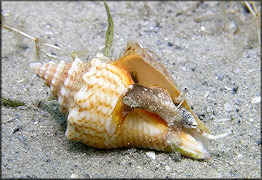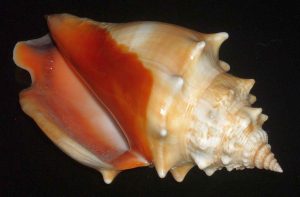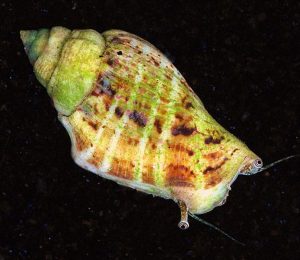Fighting Conch (Strombus pugilis) known to tropical fish keeping enthusiasts as the West Indian Fighting Conch is found in southeastern Florida, Bermuda, the Caribbean Sea, and south as far as Brazil.
Although the Fighting Conch sea snail is found on sandy, clay, and muddy bottoms, in areas within the tidal range at depths between 2 to 33 feet, divers have recorded them as deep as 180 feet.
The Fighting Conch (Strombus pugilis) is a peaceful, medium to large growing sea snail similar in appearance to the Florida Fighting Conch (Strombus alatus).
The West Indian Fighting Conch has a relatively heavy solid shell with a large, well developed body whorl, a small, short, pointed spire, and a characteristic stromboid notch. The shell has 8 to 9 whorls that each have a single row of small spines that become larger toward the last whorl, however, in some areas of collection; the spines are less conspicuous and even absent. The white interior aperture is long and slightly oblique and they have a sickle shaped operculum.
Although the interior of the Fighting Conch shell is usually white; shell colors vary from salmon pink, to cream or yellow, to light or dark orange. The front portion of Strombus pugilis has a dark purple stain that characteristically differentiates this species from the Florida Fighting Conch (Strombus alatus).
The Fighting Conch is a suitable addition to any home reef aquarium, where it will use its excellent sand sifting abilities to clean and aerate the substrate.
Like the Tiger Conch, a single Fighting Conch is best housed alone in a mature FOLR or reef aquarium of at least 30 gallon capacity with plenty of deep sandy substrate for them to sift through and feed in.
Male Fighting Conchs can be territorial towards other males of its own kind, especially when housed in a small aquarium, but they are normally peaceful towards other tankmates.
They have huge appetites and will quickly clean up algae, detritus, and leftover food in the bottom of the aquarium. When sufficient food is not present, they are also known to eat marine plants. Because of their enormous appetites, only a single Fighting Conch is recommended per 30 gallon tank. Like other invertebrates, the Fighting Conch is sensitive to high levels of nitrate and cannot tolerate copper based medications.
The Fighting Conch has been successfully bred in an aquarium and controlled laboratory environment.
In their natural habitat they reproduce throughout the year on silty sand at depths between 9 to over 60 feet. Mass orgy like copulations of multiple individuals have been recorded on silty sand bottoms with long (up to 36 feet) egg masses, with an estimated 264 embryos per 2 cm, littering wide areas of the bottom.
The egg masses of Strombus pugilis gathered from depths of 3 to 60 feet were hatched out and veligers fed natural cultures of phytoplankton. The initial stage of development where the Strombus pugilis larvae feed mainly on plankton is quite long. Juveniles fed on several species of algae that naturally appeared on the sides of the tank and on the live rock that was in the tank. After 121 days juvenile Strombus pugilis grew to a length of .84 inches.
Strombus pugillis are benthic omnivores that feed primarily on marine algae, seagrasses, detritus, and any organic matter found in the substrate. In an aquarium environment with plenty of deep sand as a substrate, they sill eat algae, detritus, and any leftover foods they can find on the bottom of the tank. Because of their huge appetites, they will quickly clean you tank of every bit of detritus and require additional supplemental feedings of small pieces of fresh fish, dried seaweed, omnivore pellets
, and high quality frozen foods with vegetable and organic matter.
The flesh of Fighting Conch is edible and in traditional Brazilian medicine is used to treat sexual impotence by local fishermen who usually boil them. Their decorative shells are also sold in local markets as souvenirs.
Tropical fish keeping enthusiasts keep the Fighting Conch (Strombus pugilis) in reef and FOLR tanks to aerate the substrate and rid their tanks of excess algae, detritus, and uneaten foods. They are readily available online from a variety of retail sources at very reasonable prices at approximate Purchase Sizes: in Asia and Tonga 1″ to 2″; in the USA 2″ to 4″.
Minimum Tank Size: 30 gallons
Aquarium Type: Established Reef or LRFO
Care Level: Easy
Temperament: Peaceful
Aquarium Hardiness: Hardy
Water Conditions: 71-78°F, dKH 8 to 12, pH 8.1-8.4, sg 1.023-1.025
Max. Size: 4″
Color Form: Orange, White, Yellow/Orange
Diet: Omnivore
Compatibility: Reef Compatible
Origin: Caribbean Sea, Florida, south to Brazil
Family: Strombidae
Lifespan: 3-5 years
Aquarist Experience Level: Beginner





One Response to “Fighting Conch (Strombus pugilis)”
Trackbacks/Pingbacks
[…] the Fighting Conch (Strombus pugilis), the Tiger Conch is best housed alone in a mature FOLR or reef aquarium of at least 30 gallon […]